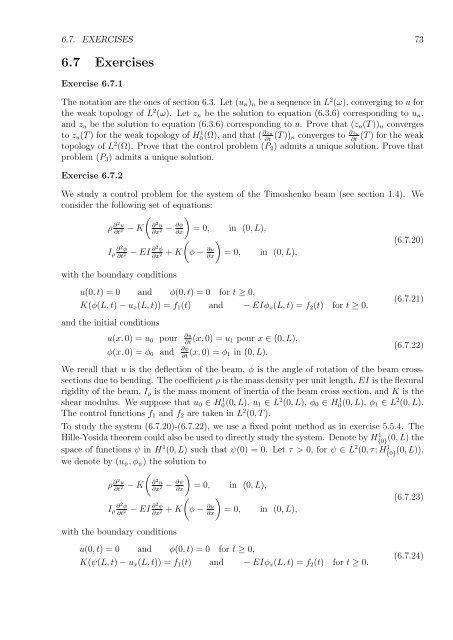Optimal Control of Partial Differential Equations
Optimal Control of Partial Differential Equations
Optimal Control of Partial Differential Equations
Create successful ePaper yourself
Turn your PDF publications into a flip-book with our unique Google optimized e-Paper software.
6.7. EXERCISES 73<br />
6.7 Exercises<br />
Exercise 6.7.1<br />
The notation are the ones <strong>of</strong> section 6.3. Let (un)n be a sequence in L 2 (ω), converging to u for<br />
the weak topology <strong>of</strong> L 2 (ω). Let zn be the solution to equation (6.3.6) corresponding to un,<br />
and zu be the solution to equation (6.3.6) corresponding to u. Prove that (zn(T ))n converges<br />
to zu(T ) for the weak topology <strong>of</strong> H1 0(Ω), and that ( ∂zn<br />
∂t (T ))n converges to ∂zu (T ) for the weak<br />
∂t<br />
topology <strong>of</strong> L2 (Ω). Prove that the control problem (P2) admits a unique solution. Prove that<br />
problem (P3) admits a unique solution.<br />
Exercise 6.7.2<br />
We study a control problem for the system <strong>of</strong> the Timoshenko beam (see section 1.4). We<br />
consider the following set <strong>of</strong> equations:<br />
ρ ∂2u ∂t2 <br />
− K ∂2u ∂x2 − ∂φ<br />
<br />
= 0, ∂x<br />
in (0, L),<br />
Iρ ∂2φ ∂t2 − EI ∂2φ ∂x2 <br />
+ K φ − ∂u<br />
<br />
(6.7.20)<br />
∂x = 0, in (0, L),<br />
with the boundary conditions<br />
u(0, t) = 0 and φ(0, t) = 0 for t ≥ 0,<br />
K(φ(L, t) − ux(L, t)) = f1(t) and − EIφx(L, t) = f2(t) for t ≥ 0.<br />
and the initial conditions<br />
u(x, 0) = u0 pour ∂u<br />
∂t (x, 0) = u1 pour x ∈ (0, L),<br />
φ(x, 0) = φ0 and ∂φ<br />
∂t (x, 0) = φ1 in (0, L).<br />
(6.7.21)<br />
(6.7.22)<br />
We recall that u is the deflection <strong>of</strong> the beam, φ is the angle <strong>of</strong> rotation <strong>of</strong> the beam crosssections<br />
due to bending. The coefficient ρ is the mass density per unit length, EI is the flexural<br />
rigidity <strong>of</strong> the beam, Iρ is the mass moment <strong>of</strong> inertia <strong>of</strong> the beam cross section, and K is the<br />
shear modulus. We suppose that u0 ∈ H 1 0(0, L), u1 ∈ L 2 (0, L), φ0 ∈ H 1 0(0, L), φ1 ∈ L 2 (0, L).<br />
The control functions f1 and f2 are taken in L 2 (0, T ).<br />
To study the system (6.7.20)-(6.7.22), we use a fixed point method as in exercise 5.5.4. The<br />
Hille-Yosida theorem could also be used to directly study the system. Denote by H1 {0} (0, L) the<br />
space <strong>of</strong> functions ψ in H1 (0, L) such that ψ(0) = 0. Let τ > 0, for ψ ∈ L2 (0, τ; H1 {0} (0, L)),<br />
we denote by (uψ, φψ) the solution to<br />
ρ ∂2u ∂t2 <br />
− K ∂2u ∂x2 − ∂ψ<br />
<br />
= 0, ∂x<br />
in (0, L),<br />
Iρ ∂2φ ∂t2 − EI ∂2φ ∂x2 <br />
+ K φ − ∂u<br />
<br />
(6.7.23)<br />
∂x = 0, in (0, L),<br />
with the boundary conditions<br />
u(0, t) = 0 and φ(0, t) = 0 for t ≥ 0,<br />
K(ψ(L, t) − ux(L, t)) = f1(t) and − EIφx(L, t) = f2(t) for t ≥ 0.<br />
(6.7.24)

















